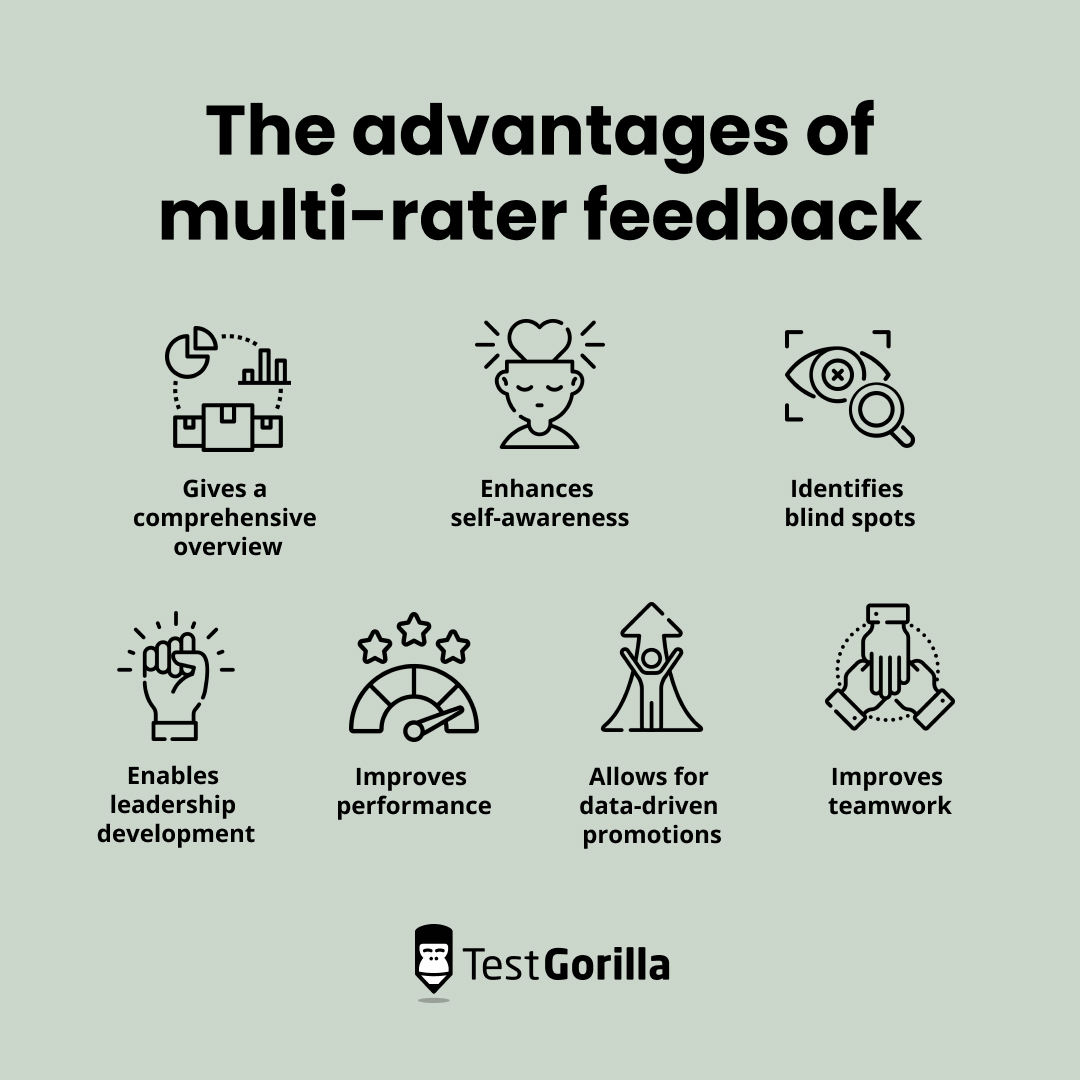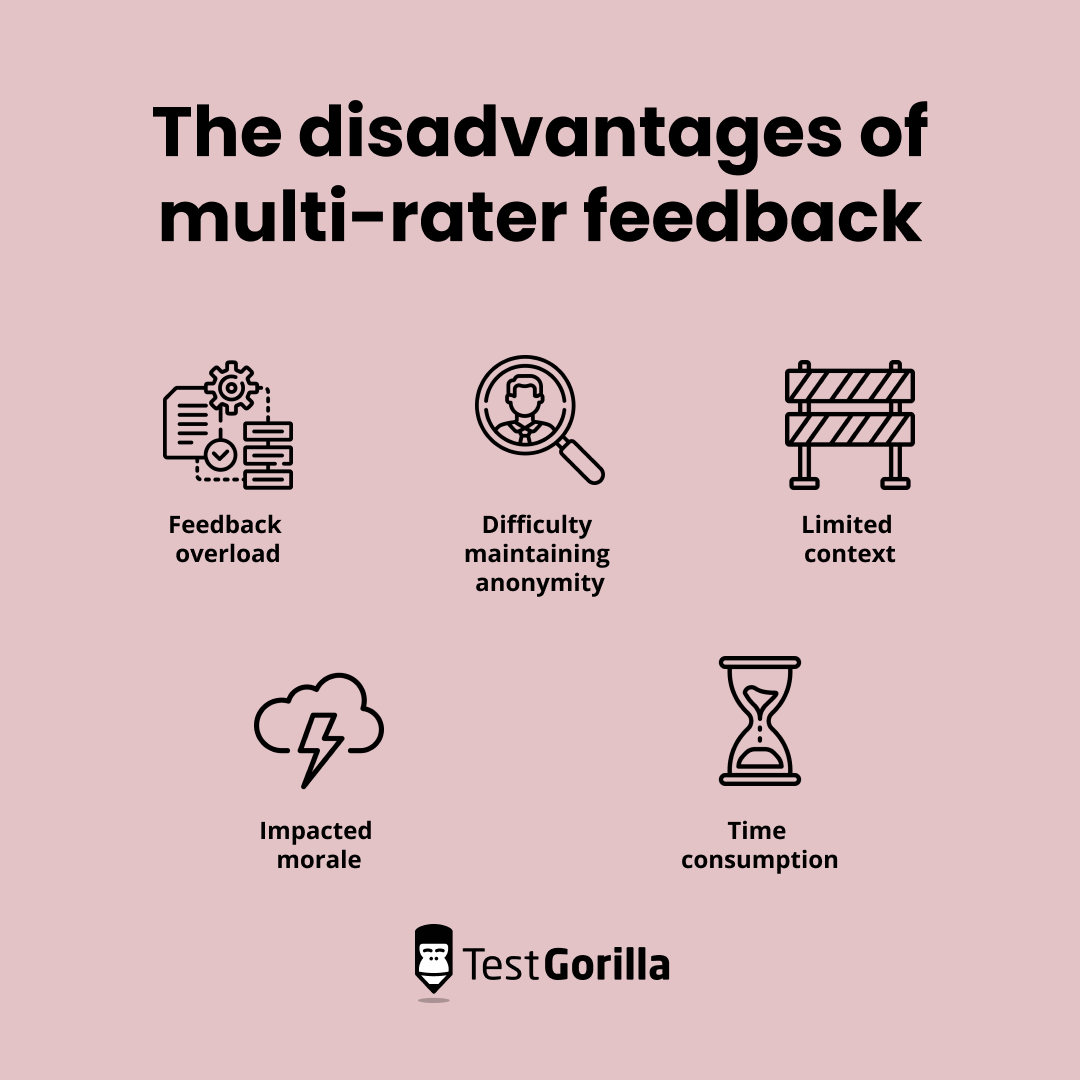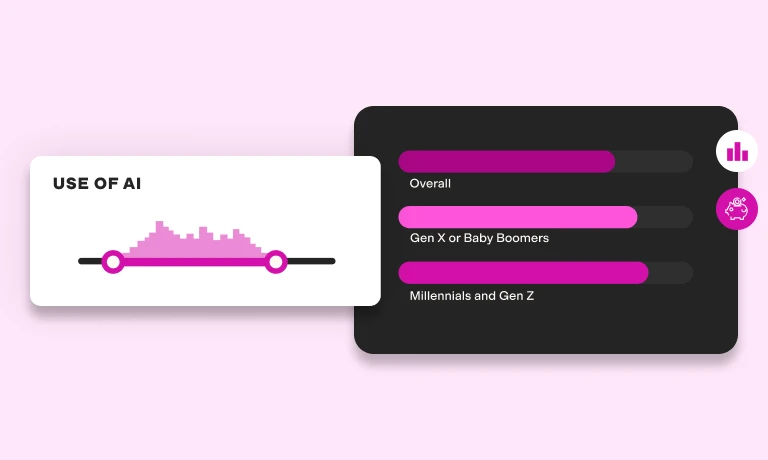Giving timely and constructive feedback to your employees is essential for building a high-performing workforce. However, relying solely on spontaneous or manager-led feedback can cause the feedback to feel one-dimensional, biased, or even counterproductive. Feedback that feels unfair or uninformed can demotivate employees or erode their trust in managers.
To prevent this, you should use a comprehensive feedback approach like multi-rater feedback. This feedback style uses multiple feedback channels to encourage open communication, increase self-awareness, and improve performance. Plus, investing in this feedback method demonstrates your commitment to your employees’ development, which will inspire trust and motivation in your workforce.
However, you can only reap the benefits of this feedback approach if you implement it with care and precision.
Read on to learn the pros and cons of using multi-rater feedback, the steps to collect it, and five essential tips for maximizing it
Table of contents
- What is multi-rater feedback?
- Should you adopt multi-rater feedback at your company?
- The advantages of multi-rater feedback
- The disadvantages of multi-rater feedback
- How to collect multi-rater feedback
- 5 essential tips for maximizing multi-rater feedback
- Upgrade your employees’ performance with multi-rater feedback
What is multi-rater feedback?
Multi-rater feedback is a performance evaluation tool that collects employee performance feedback from multiple channels. It can be more beneficial than traditional manager-led feedback because it offers a well-rounded perspective of your employees’ achievements and capabilities.
Multi-rater feedback can include the following:
An employee’s self-assessment. This is where an employee evaluates their own performance. A self-assessment provides insight into how your employees believe they’re performing, what additional training they might need, and how they feel about their role. For example, is their role too challenging, or are they seeking more learning opportunities and responsibility?
Peer feedback. Your employees' peers include those in their team, department, or office. Peer feedback is a great way to understand a candidate’s communication and team-building skills and contributions to company culture.
Direct reports. Asking team members to assess their line manager can provide insight into the manager’s performance and leadership skills, decision-making, and conflict-resolution skills.
Supervisors or managers. Feedback from an employee’s supervisor or manager is a standard part of their evaluation. These individuals have a good idea of the employee’s performance and skills, which they should include in their appraisal.
Customer feedback. This can measure performance for customer service or sales-based roles. However, always take customer feedback with a pinch of salt in case a bad sale or complaint influences the customer’s feedback.
Multi-rater feedback that considers all the above perspectives is often called 360-degree feedback, as it offers an all-around evaluation of the employee.
After a company collects multi-rater feedback, managers can use it to have discussions with employees about their work performance and set goals for improvement.
Should you adopt multi-rater feedback at your company?
Before deciding whether you should implement a multi-rater feedback model at your organization, you should consider the following:
Resources
The first thing to consider is whether your business has the resources to implement a multi-rater feedback model. To properly implement this feedback method, you’ll need:
Time. While rating peers and supervisors will take between 30 minutes and an hour, managers need ample time to analyze the feedback, organize and hold feedback discussions, and support employees in setting actionable goals. No one task will take too long, but all tasks combined can be time-consuming.
Money. Your company will incur expenses associated with training, time spent gathering and analyzing feedback, and feedback tools.
Technology. You’ll need the appropriate technology to use and analyze multi-rater feedback – for example, dedicated multi-rater feedback software, a data analysis tool, or even simple spreadsheet software.
Purpose
You should also consider what you hope to gain from multi-rater feedback. For instance, this feedback approach can help with leadership development, performance improvement, talent management, and succession planning.
Adopting this approach without a purpose can lead to a disjointed feedback process, misalignment with organizational goals, and the potential for valuable insights to go untapped.
Legal and ethical considerations
There are ethical and legal considerations to make when using multi-rater feedback. For example, in some states, you must store collected data in line with local security and data-handling laws. Responsible data management is vital for safeguarding sensitive information.
Also, respecting the confidentiality of employee feedback shows your dedication to fostering an ethical workplace culture where individuals feel comfortable sharing their opinions, thus nurturing trust and transparency within your team. This is why most multi-rater feedback is anonymous. Maintaining anonymity ensures employees feel comfortable providing honest feedback without fear of retaliation.
Employee buy-in
Evaluate employee buy-in and support for the feedback process before implementing this new feedback style. You can do this by holding one-on-one discussions, conducting surveys, or holding focus groups.
This can help you address any concerns your team has and ensure everyone is on board and engaged. In turn, you’ll avoid misunderstandings and resistance from your employees.
Alternative approaches
Although multi-rater factor feedback is a powerful tool for performance evaluation and improvement, you should also consider alternative approaches to feedback and performance evaluation.
These include traditional yearly manager-led assessments or feedback based solely on key performance indicators like sales revenue generated, customer satisfaction scores, project completion rates, or mistake rates.
All feedback methods have pros and cons, so it’s important to consider all your options before deciding.
The best insights on HR and recruitment, delivered to your inbox.
Biweekly updates. No spam. Unsubscribe any time.
The advantages of multi-rater feedback
Gives a comprehensive overview
The biggest advantage of multi-rater feedback is that it gathers input from multiple perspectives. Also, because it aims to gain a complete overview of your employees’ skills and competencies, it can be one of the fairest ways to gather feedback.
Enhances self-awareness
Multi-rater feedback promotes self-awareness by helping individuals understand how their actions and behaviors impact others in the organization. This insight is valuable for personal and professional development.
Identifies blind spots
Multi-rater feedback can reveal individuals’ blind spots and highlight any areas where your employees may need more training.
For example, consider a manager who says they have strong training skills in their self-assessment but receives subordinates’ feedback that rates their training skills poorly.
This scenario could indicate that the manager isn’t aware they aren’t training effectively. Multi-rater feedback can help you identify this blind spot and pave the way for you and your employees to address it.
Enables leadership development
This feedback approach is especially beneficial for developing workplace leadership skills since it helps managers and other leaders understand their impact on teams, as well as their contributions to company culture. Plus, it can identify areas where a future manager may need further training.
Improves performance
Multi-rater feedback gives realistic and actionable insights into an employee’s performance. Managers can then use these insights to create improvement plans and set goals for their team members.
Allows for data-driven promotions
Data from multi-rater feedback scores can support internal development and promotions. For example, if two employees do equally well at their promotion interviews and you can promote only one, you could use their historical performance reviews to decide between them. This data-driven approach enhances transparency, objectivity, and fairness in the promotion process.
Improves teamwork
When employees know their peers and managers are partially responsible for their appraisals, they’ll likely be more motivated to collaborate and work effectively as part of a team.
The disadvantages of multi-rater feedback
Feedback overload
Feedback from multiple sources may subject some employees to feedback overload – a concept used to describe employees who feel overwhelmed by feedback and find it difficult to process effectively.
If you know your employees are prone to feeling feedback overload, try delivering their multi-rater feedback across multiple sessions so they have time to process the information. Or, pair constructive comments with praise.
Difficulty maintaining anonymity
Although maintaining anonymity with multi-rater feedback is important, this can be difficult to do with small teams. Small teams can usually tell who provided the feedback from the tone or the content of the input.
Additionally, while anonymity is meant to encourage honesty, it can also lead to unhelpful or even malicious comments.
Limited context
Feedback often lacks context, making it difficult to understand the circumstances or factors contributing to comments. For example, if an employee is going through a tough time and performing poorly as a result, these challenges likely won’t be reflected in their peer feedback.
Impacted morale
If not handled sensitively, negative or even developmental feedback from teammates can damage relationships, demotivate teams, and negatively impact morale.
Imagine that an employee receives mostly negative feedback from their peers and managers, despite themselves believing they try their best at work. Such feedback delivered without compassion may significantly lower the employee's morale, leading to feelings of discouragement and frustration.
Time consumption
Although comprehensive, multi-rater feedback can take a long time to gather, analyze, and implement with your team.
How to collect multi-rater feedback
Implementing a multi-rater feedback system without the proper training or tools will lead to team confusion, and employees might feel overwhelmed. This could result in poor-quality feedback and a demotivated team.
Try using this step-by-step strategy to help you roll out a successful multi-rater feedback program:
Clarify your objectives
Clearly define what you hope to gain from multi-rater feedback. Are you hoping to improve performance, enhance internal progression, or gain deeper insight into your employees' strengths? Center your feedback program on your objective so it can deliver the outcomes you seek.
For example, a multi-rater feedback system aimed at improving employee performance may focus on identifying specific areas where employees can enhance their skills and competencies.
On the other hand, a feedback program aimed at fostering internal progression might focus on identifying high-potential employees and providing them with tailored development opportunities.
Determine your criteria and questions
You’ll need to decide what you want to measure using multi-rater feedback to achieve your goal. The criteria you measure should include the broader competencies and behaviors you expect of your employees, and they should inform the questions you ask and how you ask them.
Ensure these criteria align with your objectives and the organization’s wider goals. Say your goal for implementing multi-rater feedback is to improve employee performance, and one of your business’s objectives is to increase customer satisfaction. In this case, your multi-rater feedback should probably measure communication skills and conflict resolution abilities. You can ask questions like, “On a scale of 1-5, how well does your colleague communicate?”
Choose feedback tools
Once you’ve clarified your goals, create or adopt feedback tools that your employees can use. Will you use online surveys, paper-based forms, in-person interviews, or multi-rater feedback software?
Whatever you choose, you should maintain consistency to ensure transparency, standardization, and efficiency across your multi-rater feedback.
To decide which tools will be best for your business, consider:
Scalability. If you expect your business to grow, you’ll need a multi-rater feedback tool that can scale with you. For instance, online surveys offer a happy medium for small businesses and larger organizations.
Data analysis needs. Consider the level of data analysis you’re hoping to conduct. It’s much easier to analyze data from a survey or database than from paper-based forms or in-person interviews.
Cost. How much are you willing to spend? While some tools (like in-person interviews) are free, others (like specialized multi-rater feedback software) come at a cost.
User experience. A dedicated multi-rater feedback platform or online survey tool typically offers a better user experience than a paper-based form. However, an in-person interview is an opportunity to sit, have coffee, and develop a rapport with your employees, which could greatly improve their experience of giving feedback. Pick the tool that provides the best experience for your team.
Communicate the program
The next step is to communicate your new feedback program to your employees. Your workforce needs to understand what they need to do, how they need to do it, and why it’s important. Be sure to communicate the benefits of multi-rater feedback to your team to minimize resistance and create a positive environment for giving and receiving feedback.
You could send a company-wide email, ask managers to share the news with their teams, or host a meeting to introduce the new feedback program.
Train employees on giving feedback
Proper training ensures your company gets the most out of multi-rater feedback. Managers must be able to properly handle, interpret, and take action on the data collected from these surveys. Additionally, employees may need training to help them understand what to include in multi-rater feedback.
Training should cover how to give objective feedback, how to frame observations, and how to focus on behaviors and outcomes rather than personal judgments. Employees should also learn how to use feedback tools. Additionally, managers should learn how to hold meaningful feedback conversations and coach their team effectively.
Training improves the quality of feedback given and enables employees to give and receive feedback with confidence. You can offer one-on-one or group training sessions, or you can use online training platforms. It may also be beneficial to set up an FAQ document or a Q&A session for ongoing support.
Solicit feedback
The next step is to ask your team, managers, and employees to provide feedback. Give them time during their workday to write feedback or fill in their surveys to ensure it doesn’t distract from their usual workday. Around 30 minutes to an hour should do – depending on how many of their peers they need to rate.
Follow up
Once you’ve collected your feedback, analyze the data and encourage other line managers to follow up with their team through one-on-one feedback sessions.
During these feedback sessions, the manager should deliver the feedback collected, ask for the employee’s opinion on the feedback, and set some goals based on the feedback.
For example, say an employee’s multi-rater feedback states they’re a great teammate but their typing speed is slow and they struggle with problem-solving. Their manager might set these goals:
Take training course to enhance problem solving
Spend 15 minutes every day practicing touch-typing
Increase typing speed from 65 WPM to 85 WPM
Managers should also offer training to employees to support them in achieving their goals and have regular follow up meetings to check on employees’ progress.
How often to collect multi-rater feedback
Although beneficial, multi-rater feedback can be time-consuming and disrupt your employees’ work day. When using multi-rater feedback, it’s important to balance the need for consistent feedback with the need for productivity.
Ultimately, there’s no one-size-fits-all answer to how often you should collect multi-rater feedback. Your strategy should align with your organization’s culture, goals, and capacity while considering your employees' needs.
You should conduct feedback sessions at least once per year. It’s unlikely that you’ll need to complete feedback sessions more than once a quarter. Try using bi-annual feedback sessions to strike a happy medium.
5 essential tips for maximizing multi-rater feedback
Use a mix of qualitative and quantitative data
Quantitative data can indicate employee performance through numbers and scales – for example, scores on a 1-5 rating scale. Qualitative data can show employees’ performance through non-numerical information like open-ended comments. Using a mix of both gives a better overview of an employee’s performance, strengths, and areas for improvement.
For example, your self-assessments might ask employees to rate specific qualities, like their learning agility, using a numerical scale. They can also include questions requiring short written responses – e.g., “During the last year, what have you achieved in the workplace that you’re most proud of?”
Use ongoing skills testing as part of feedback
You can use skills and aptitude assessments as one channel of multi-rater feedback. For instance, TestGorilla’s library contains 300+ scientifically backed tests that measure job candidates’ skills objectively and consistently – but these tests aren’t just for candidates. They can also help you continually test your existing workforce’s skills and traits.
For example, an employee whose peers say they have poor written communication could take a communication skills test. Test scores showing they struggle with communication will validate their peers’ feedback. This can help you determine the next best course of action, such as setting communication goals for the employee and providing further training.
Follow up regularly
Regularly following up on multi-rater feedback ensures the feedback stays at the forefront of your employees’ minds so they can act on it appropriately. Plus, frequent check-ins help you build strong relationships with your employees.
Promote a culture of feedback
Promoting a feedback-rich culture in the workplace ensures your employees are open to giving and receiving constructive criticism. Regular feedback sessions outside of multi-rater evaluations foster trust in the feedback process, ultimately maximizing the effectiveness of these evaluations and supporting continuous professional growth and development.
Keep a record of verbal feedback
Although not legally necessary, keeping records of verbal feedback and coaching given to your employees is good practice. These act as a documented history of an employee’s performance and their development in their role. You can then look to this information when considering employees for promotions or developing personalized training for them.
Upgrade your employees’ performance with multi-rater feedback
Multi-rater feedback is a comprehensive feedback method designed to give employees an in-depth understanding of their performance. This enables them to improve their performances and fill gaps in their knowledge. Plus, this method contributes to a feedback-rich and high-performing workplace culture, which ultimately drives business success.
You can collect multi-rater feedback from an employee’s manager, peers, subordinates, and customers, the employee themselves, or through pre-employment testing tools like TestGorilla. Each piece of feedback offers valuable insight into an employee’s overall performance, creating a holistic picture of an employee’s strengths and areas for development.
Get the most out of your multi-rater feedback by signing up for a free product tour with TestGorilla. If you’re ready to take the plunge, get started with your free plan today!
You've scrolled this far
Why not try TestGorilla for free, and see what happens when you put skills first.

















